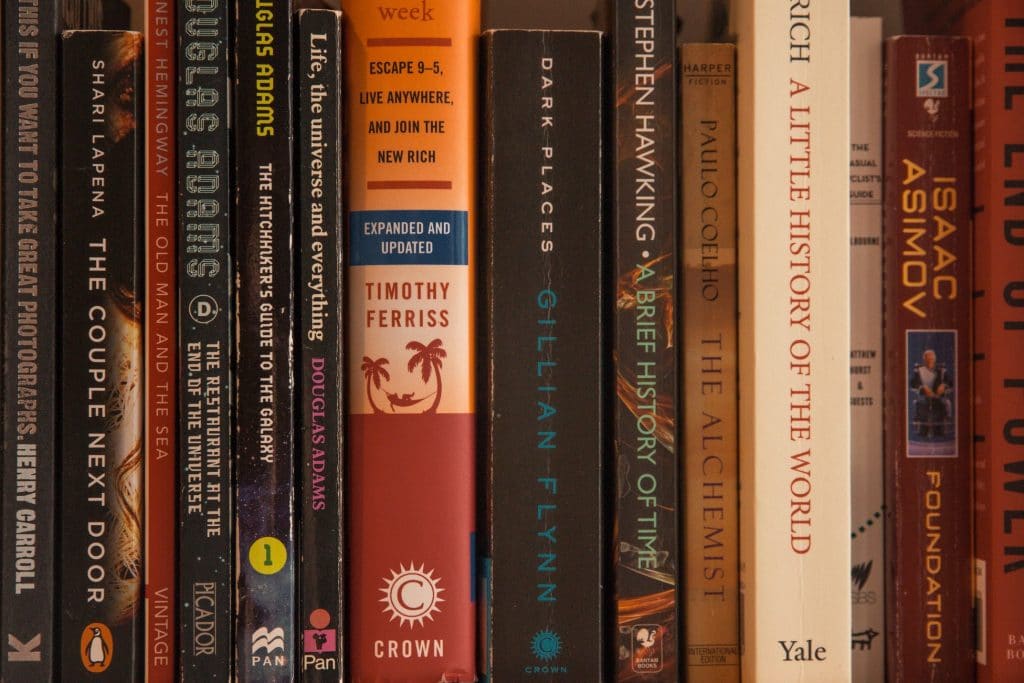In my last post, we considered the power of story as a facet of human growth and survival. That story is so deeply embedded into who we are and how we think, it emerges not only in the fiction and nonfiction book we’re working on, but in nearly every interaction we have.
Especially in this time of isolation, polarization, and digital frenzy, the argument could be made that our stories are all we have left. The evolutionary advantage belongs to the person(s) who can best craft a story with a well-calculated arc and send it right to the heart of their targeted reader.
But analysis of story done for our own benefit only gives us the advantage of survival. We come to discover the truth, weigh incoming messages against that truth, and deflect whatever doesn’t measure up for us.
Analysis is the shield that keeps weaker stories from hitting their intended target—our thought patterns and beliefs. But a shield is only good for so many at once. In fact, it’s really a just personal protectant.
Yes, we can influence our children, peers, and great-aunts-who-just-got-on-Facebook, but only to an extent. If you have a story in you—and, I would argue, we all do—then you can create a much broader impact in the world by sharing it. You have every ability to craft stories that move your reader and shift their thought patterns and beliefs, and because your story will work, it should do so to some significant scale.
If you’re cringing or coming up with excuses about why your nonfiction book won’t work, isn’t working, or can’t work, this post is for you.

How Analysis Blocks Nonfiction Books
As self-proclaimed Story Nerds, at some point, the shield becomes a place to hide rather than a tool to help us forge on. Ask me and my unfinished 20k word draft how I know. Analytic joyrides can keep me up all night long picking apart narrative device, the protagonist’s arc, and who in the world Hamilton is actually about—but when it comes to my own story arrows, the energy shifts. I either join the ranks of keyboard warriors sending out half-formed thoughts before I can think twice to test them, or hoard my story-making supplies as if the intellectual zombie apocalypse weren’t already here, begging me to join the front lines.
I’m going to write it, I swear, I protest. But first, give me one more book on craft…
If you’re a Steve Pressfield fan, you’ll recognize resistance here. If you’re a perpetual imposter like me and most of my colleagues, you’ll recognize paralysis by analysis. And if you’ve been following the Big Idea Nonfiction conversation, you might find a way to make the author-as-protagonist journey stretch on indefinitely, until it’s “just right.” Until you’ve learned enough, researched enough, lived enough. Until you can rival Gladwell. Meanwhile, your target—your intended reader’s thought patterns and beliefs—are being bombarded by everyone else’s stories. Everyone’s but yours.
There are many reasons one might choose to write a nonfiction book over fiction, which we’re not going to unpack here. But one key difference in writing nonfiction over a novel is the direct link between you and the reader. You have some experience, knowledge, insight, or wisdom that some part of you believes a reader would benefit from, and they need to hear that insight directly. A buried metaphor isn’t going to cut it. And, again on some level, you believe you possess or can come to possess that wisdom.
That’s a pretty powerful belief. If you have access to wisdom that someone else needs, why on earth haven’t you shared it yet?
The short answer is resistance. Everyone has their own varying roadblocks, but the only reason we get hung up on them is because it’s a convenient way to give into those loud fears, doubts, and imposter messages that are trying to keep us “safe,” which is brain-code for “unchanged.”
Our brains are so good at this coding, that we can convince ourselves of nearly anything this way. There’s no way to address them all directly here, so let’s boil it down to three:
- That we haven’t lived enough life to recount a story yet
- That we aren’t skilled or informed enough to tell the story yet
- That we aren’t the person to tell the story at all
If I wrote my book in the way I told myself these stories, I’d never doubt my skill, experience, or relevance again. I sell these stories to myself, and I bet you do too.
Admission is only the first step toward resolution, however. If the recognition of resistance were enough to get us through difficult projects, there would be no need for this community. We would have all put The War of Art down, walked away, and rocked our work all the way to the finish line without ever wondering who helped him develop that lovely little book and what he might have been thinking while editing it.
Here’s what I propose:
- Experience is relative, and we all have something to share with someone else
- You have every skill, tool, and resource that you need to complete your book
- You are a key part of your story—in fiction and nonfiction alike
That brings us back to the last post and the beginning of this one: sitting in our writing rooms, amassing writing and editing tools. Holding our story analysis shields up to the brick wall of resistance, wondering how we’re ever going to reach the other side. Meanwhile, our story arrows are right there, waiting to be let loose over the wall.

Stop Trying to be Gladwell
They say comparison is the thief of joy, but no one tells you how lethal it can be for your confidence.
Masterworks used properly give us an opportunity to learn and mirror. I can learn just as much from The Tipping Point to help edit a knitting how-to eBook as I can about an epic Big Idea—even if it’s to identify what I’m not writing. Masterworks used as resistance become a point of comparison that keeps us from moving forward in our own strengths.
Stop trying to be Gladwell.
The next time you grab a masterwork to help you craft and refine your nonfiction book, pause for a moment to consider the author’s context as well as their work. Who are they writing to? Why are they writing? What will they get from that book, and what will their readers get?
If you’re aligned in context, you can hold that comparison much closer and learn much deeper lessons than when you’re coming from different worlds.
As a white woman born in the ‘80s, I cannot presume to mirror James Baldwin’s work and wouldn’t try to. I can learn from his structure and presentation, but I can’t measure my work against his. Our contexts are entirely different. Similarly, imagine a world in which Baldwin held his works up against Gladwell and decided it wasn’t worth pursuing.
Sadly, we’re in that world and can’t possibly know the impact. So many stories are going untold because comparison, imposter syndrome, and perceived inadequacies hold them back. I speak with authors who hold themselves back because Gladwell—or Nasim Taleb, or Brene Brown, or Daniel Kahneman.
Let’s make this super simple: Are you a journalist? A researcher? Currently a nonfiction author and speaker by trade?
If you are, go do your thing. Use their work to level your nonfiction book up.
If you’re not—and few of us actually are—stand in your own strengths.
You already have access to the tools you need to level up your craft and get your book out into the world. What skills you don’t possess, our community, courses, and editors can help you with. But it starts with a draft, which begins with an idea, which is driven by your desire to help your readers grow. Don’t let comparisons get in the way of the important work ahead.
Experience is relative—we all have something to share with someone else.
The Reader Can Be Your Protagonist
For a quick rewind on nonfiction book theory, there are four basic types of story frameworks we’ve identified within the Story Grid methodology: Academic, Narrative, How-To, and Big Idea, with Big Idea as a combination of the three others. Theoretically, nonfiction is a subset of Worldview Revelation (moving from ignorance to wisdom), and there are conventions and obligations to guide you just as there are for fiction genres.
One key convention that tends to scare people off is the author-protagonist. When nonfiction first started to show up under the Story Grid lens, Shawn said this:
…in The Tipping Point, Malcolm Gladwell is clearly the protagonist of the story. He’s the one telling the events by which he learned about the tipping point and he walks us through the various stages that he went through in order to analyze, formalize and mechanize that big idea.
And he’s right. The author-protagonist is a compelling way to present a nonfiction book to your readers, especially Big Idea. In this, the author is a changing character who comes to embrace the revelation over the course of the book. Why does this matter? One of the most significant ways that we as humans absorb new information is through the vicarious experience of another person. If you’re relaying deep analytical wisdom or leaning heavily on an academic presentation of research, the reader is going to keep up with you if you are on the journey with them.
This bottom-up approach, that grows the wisdom rather than imparting it, is what separates an academically heavy Big Idea book from straight up academic text.
But there’s another option: the reader-protagonist. In this scenario, the author is a static “character” who has already come to realize the idea, and the reader is going to make the big shifts as they move through the book.
I find this is especially revelatory for nonfiction authors writing business books. The idea of going on a new journey, or even walking step for step through an old journey, is overwhelming and intimidating. It’s enough of a concern that many of them want to pull back to “just” write how-to or “just” write narrative/memoir.

How-to, narrative, and memoir are absolutely valid choices and may be the right one for your book. But if you’re just making that decision out of fear or intimidation, you can’t definitively say it’s the right one for your book.
So let’s take author-protagonist off of the table for a minute. You don’t want to go on a new journey and aren’t interested in walking through yours (more on that in a minute). What’s left?
The reader-protagonist has a different focus. It assumes the author is in a static place, and the reader is the one who is going to move to meet you. While it can get messy to layer a full and complete Hero’s Journey archetype onto something like a business book, the bones of it can be helpful. The reader-protagonist is the hero, and they are going to experience similar arcs and pits of despair as they attempt to acclimate to your Big Idea.
In this scenario, think of yourself as the threshold guarding and mentor, and the reader as the hero. How are you going to invite them into the new world of your Big Idea, give them the lay of the land, help them test out their “new” skills, and ultimately unearth and realize the abilities they had all along so they can return to their world a changed and victorious hero? There’s your Big Idea book.
You already have every skill, tool, and resource that you need to complete your book.
Weighting the Big Idea Nonfiction Book
The same principles will work for your nonfiction book no matter who your protagonist is—you’ll still analyze, mechanize, and formalize a concept. You’ll still invite them to see the world differently. You’ll still use academic, how-to, and narrative concepts to drive the story and hammer home the ideas. And no matter what you’re writing, it’ll all be in service of the reader and what they’ll get out of it.
The difference is simply in the way those components show up. It’s in point of view/perspective and, I believe, in the “weight” of the Big Idea components. While all Big Idea contains academia, narrative, and how-to bubbles, some are weighted more toward one bubble than the others.
The author-protagonist shows up in academic driven books as a progressive revelation of the way the author came to and unearthed the Big Idea—Thinking Fast and Slow, The Tipping Point, Daring Greatly, The Fire Next Time, Silent Spring. Academic weighted Big Idea puts the research center stage, and acclimates you to it through the experience of learning it bit by bit. The author’s perspective or journey is sprinkled in to remind you that there was a point in time when they didn’t know this thing either, and that you can learn it just like they did.
Narrative weighted Big Idea puts the author’s story center stage, validating their learned experience with sprinkles of academia to back it up and how-to that gives you something to do with it. The Fire Next Time is a beautiful example of a book that doesn’t have to be long, academically heavy, or drafted from a brand-new journey in order to still be a powerful, world-changing Big Idea. Shelley breaks down more about this incredible memoir-esque Big Idea in her post.
Finally, we have how-to weighted big idea. We think of how-to as the gardening, building, cookbook, tactical instruction manuals, but it goes way deeper than that. It’s the 7 Habits of Highly Successful People, Think and Grow Rich, and Leaders Eat Last kinds of books that authors can leverage to relay their lived experience in a way that brings readers into a place of wisdom that they already inhabit.
If we’re following the other patterns, would put the call to action center stage. What does the reader need to do in order to actualize this idea, validated by narrative experiences and academia that proves it’s worth the effort? In this context perhaps more than the others, the reader is clearly and obviously the focus. The invitation to the new, mechanized concept/world is clearer, because the instructional components are stronger.
There’s a lot to explore here that I suspect we will all continue to do within the Story Grid Universe, but the takeaway here is this:
You don’t have to go on a new journey to write Big Idea.
You just have to bring the reader along.
You are a key part of your story, like it or not
The Author on the Page
Here’s the catch: there is absolutely no way to remove yourself from your story. Not if you want it to work. Remember, story is how we relay our experience in order to create safety and preserve life. On that deep, dark, caveman level, do you think I’m going to trust your story about which berries are safe if you don’t tell me anything about how you came to know that?
I don’t care if you’re writing a nursery rhyme for a picture book, bringing yourself onto the page in some way is the connection point that readers are looking for.
The question of author-protagonist or reader-protagonist is simply about the primary journey happening as the story unfolds. The weight of your Big Idea nonfiction book is simply a decision about how that journey moves forward.
Straight-up academic texts will have author credentials somewhere on the page. Basic how-tos will show images of what you’ve crafted, or descriptions of mistakes and shortcuts you discovered along the way. Memoir that doesn’t dig deeply enough to become authentic and vulnerable just won’t land as well as it should. And fiction—well, that’s a whole melting pot of your lived experience, perspective, biases, and assumptions, like it or not.
There’s no way around it. You are a key part of your book.
That terrifying truth is at the heart of every story we tell ourselves that stops our books from coming to life. There’s something about ourselves that we deem inadequate, and we’re afraid those inadequacies will show up on the page.
And they might. That’s what makes us so tragically, beautifully human. And it’s what your readers need to see before they will follow you into the pit and back out again.